Why was the Temple destroyed?

Massechet Yoma, Daf 9 + Throughout Massechet Yoma, we get a glimpse into life with the Beit Hamikdash, the holy Temple, intact. On daf 9, for example, we're told the reasons for the destruction of Jerusalem's holiest place. We read that the first Temple was destroyed because of three cardinal sins - idolatry, adultery and murder. The prophets warn the people of their imminent demise because of these actions - see Jeremiah, chapter 9: "So that I might leave my peopel... for they are all adulterers, a crowd of unfaithful people." The Second Temple, our sages tell us, was destroyed due to unbased hatred among brothers. The Temple authorities were widely perceived as corrupt. Josephus, the first century Jewish historian writing from the Roman court, tells us in his book "The Jewish War" that during the siege of Jerusalem the generals said there's no need to attach the city, the Jews will kill each other..." *** A talented friend and teacher



